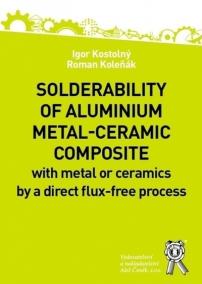Solderability of aluminium metal-ceramic composite
Dátum vydania: 15.04.2021
Flux-free soldering of a metal-ceramic composite is currently a technology that offers a number of advantages. In addition to high financial savings on the flux, the technology provides the elimination of other undesirable phenomena such as contamination of materials with the flux and the associated absence of cleaning the joints. The main problem is to ...
Bežná cena knihy: 8,80 €
Naša cena knihy: 7,04 €
Ušetríte: 20 %
Dostupnosť: Posledný kus na externom sklade
Detaily o knihe
Počet strán: 100
Rozmer: 148x210 mm
Jazyk: česky
EAN: 9788073808372
Rok vydania: 2021
Zákazníci, ktorí si kúpili túto knihu, si kúpili aj...
O knihe
Flux-free soldering of a metal-ceramic composite is currently a technology that offers a number of advantages. In addition to high financial savings on the flux, the technology provides the elimination of other undesirable phenomena such as contamination of materials with the flux and the associated absence of cleaning the joints. The main problem is to ensure the wettability of these materials, which are not wettable by solders due to the surface oxide. Disruption of this layer can be realized in various ways. One of the most commonly used methods is ultrasonic soldering technology. An important factor is the use of a solder alloy, the chemical composition of which presupposes reaction with the surface of the composite material. These reactions can result in the formation of intermetallic phases with the metal component of the composite. In this work, the microstructure of the joints at the solder/substrate interface is studied. Soldering is realized by Zn-based solders with the addition of other elements to improve the properties of the joint. By observing the microstructure of the joints, the dissolution of Al in Zn was clearly visible on the part of the composite material. This resulted in the movement of Al2O3 particles from the composite material towards the volume of the solder. Strength is assessed by measuring the shear strength of joints. The strongest connection was achieved using ZnAl5 solder. The lowest average value was achieved with the ZnIn10Mg1. The addition of In in the Zn solder thus results in a significant reduction in the strength of the joints.













